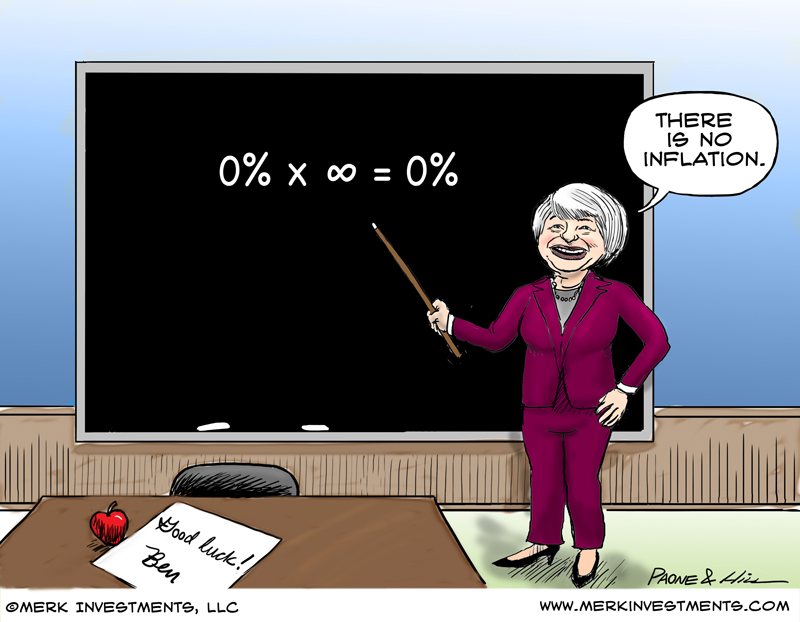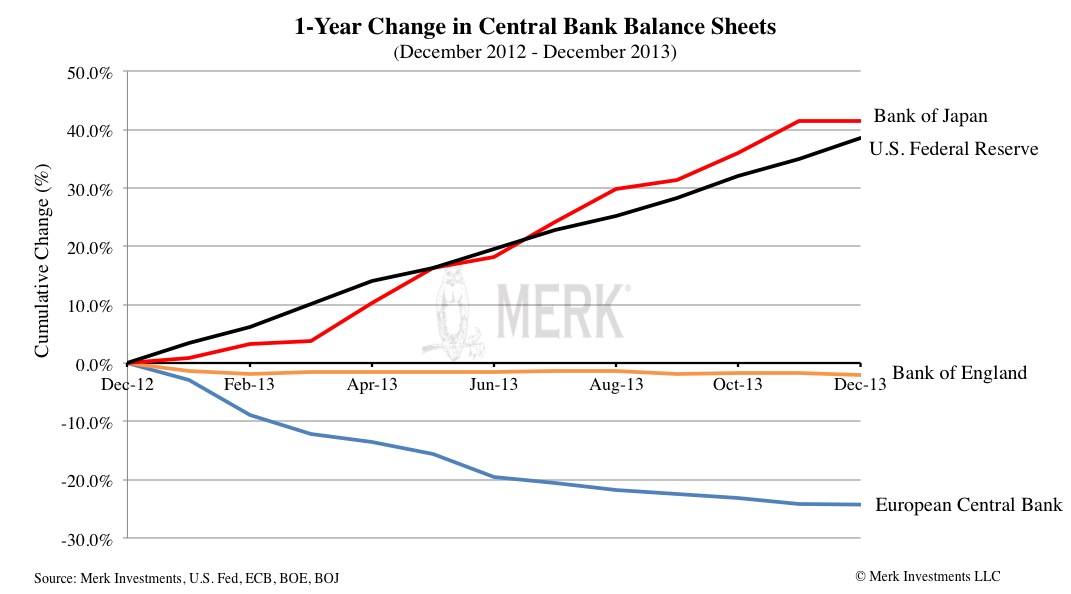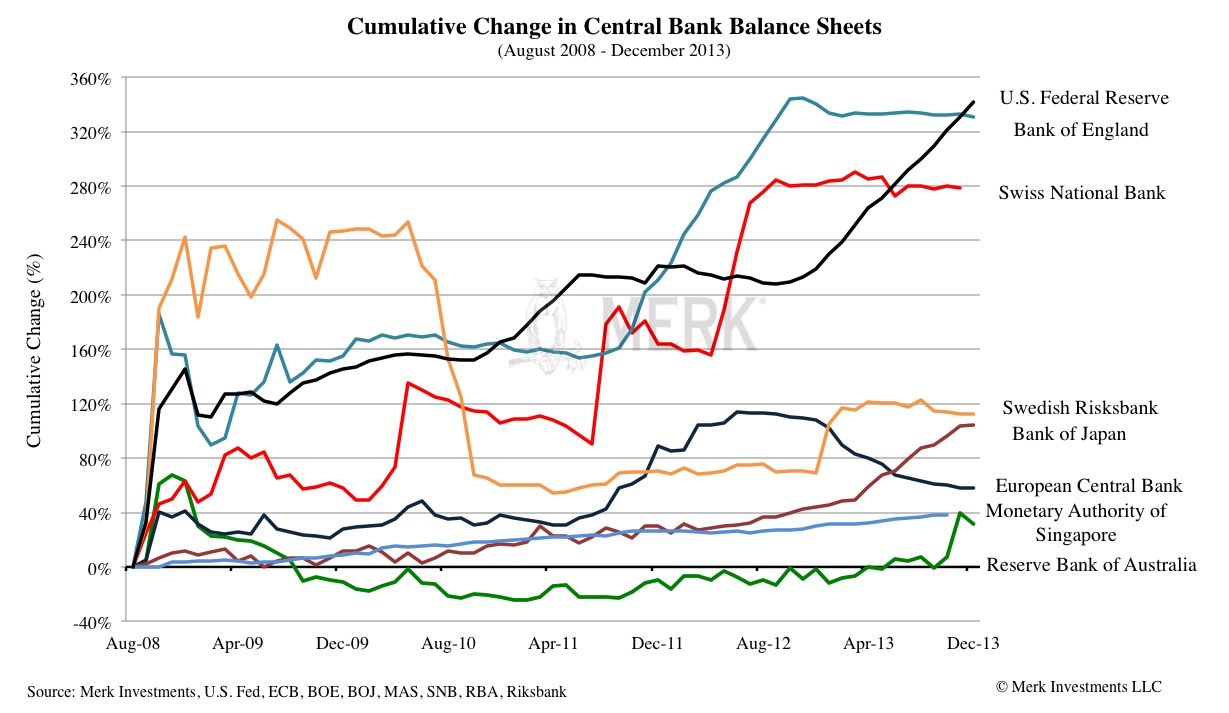Merk 2014 Dollar, Currency & Gold Outlook
Axel Merk, Merk Investments January 14th, 2014 Rarely has the future been so clear. Really?? A lot of money has been lost jumping on the bandwagon. Letís do a common sense check on the greenback to gauge where risks might be lurking and where there might be profit opportunities for investors. Nothing normal about U.S. monetary policy During her confirmation hearings, incoming Fed Chair Janet Yellen testified that U.S. monetary policy is to revert towards more traditional monetary policy once the economy is back to normal. With due respect, in our assessment, that’s an oxymoron. In a “normal” economy capital is allocated according to the risk profile of the project under consideration. However, when the Fed actively distorts the price discovery mechanism with its QE programs, we believe it is impossible to move back to a normal economy. Inflation promise?
The Fed has told the market in no uncertain terms that it is in no rush to raise rates. Outgoing Fed Chair Bernanke often argued one of the biggest policy mistakes during the Great Depression was to raise rates too early. Trouble is, removing stimulus might allow deflationary forces to take over once again, negating the “progress” that’s been made with cheap money. We interpret that to mean the Fed has all but promised to err on the side of inflation. Yellen is said to favor a rules-based approach to setting policy rates. In theory, that’s laudable, except that Yellen in particular appears to prefer “rules” that heavily discount inflation indicators in favor of employment indicators. Hawkish Fed? Do Pigs Fly? There is a bewildering opinion shaping that a Yellen Fed will be hawkish, especially since former Bank of Israel (BoI) Governor Stanley Fischer has been nominated to become Vice Chair. Already rumors are creeping up that uber-hawk Tom Hoenig will join the team. Let’s get a few things straight:
Taper? Anyone? Let’s look across the border to get a better assessment of what all this taper talk is all about. Unlike the taper rhetoric, the practice has looked a little different. Please consider the change in central bank balance sheets across the biggest central banks:
While central bank balance sheets for the biggest countries have been indicative of currency moves, there are limits as to what these charts show. Notably, the Swedish central bank a few months ago, as well as the Reserve Bank of Australia just recently have shown a spike in the size of their balance sheets. These movements have less to do with monetary policy than to changes in regulations and payment systems, in part requiring higher cash reserves. While on the topic of Australia: the formerly beloved commodity currency took a beating last year. While pessimism reigned in Australia, New Zealand was on a tear. In fact, the Reserve Bank of New Zealand is expected to raise rates a couple of times this year. Historically, both of these currencies are highly correlated to one another. Based on fundamentals, the New Zealand dollar should do great and continue to beat the Australian dollar. However, New Zealand isn’t exactly the biggest country and its currency can be notoriously volatile. So while things look good, that provides no assurance the currency will actually do well. At some point, good economic indicators coming out of China may well push up the Australian dollar and cause substantial profit-taking in the New Zealand dollar. Norway & Sweden Throughout 2013, we became increasingly cautious about Norway. From a dovish central bank concerned about a strong currency to an increasingly populist government, we became rather disillusioned with the prospects. That, in turn, left the Swedish krona as the Nordic currency of choice. Sweden is likely to cut rates once more this year, although that action is mostly priced in. Being a smaller country, policy shifts tend to be more dynamic. Canada Oh Loonie! Once dovish Mark Carney left the Bank of Canada, we – like many in the markets – thought his hawkish deputy Tiff Macklem would succeed him. Not only did he not succeed him, he is calling it quits. Aside from losing hawkish intellectual leadership, the Bank of Canada has had, to put it mildly, fostered a benign neglect of its currency. The key risk we see with our cautious outlook for the Loonie is that we are not alone in that view. Emerging Markets Emerging markets tend to be less liquid than developed markets. Last spring showed this matters: when volatility spikes because of uncertainty over the future course at the Fed, the previously perceived free lunch in capturing yield with low volatility in emerging market local debt markets causes stomach cramps. Not only will we likely have local disturbances with numerous elections coming up in emerging markets, but we think the heavy hand of policy makers in major economies may well persist. Most vulnerable in this context are the weaker EM countries – those with current account deficits. The notably exception here is India, where Reserve Bank Governor Raghuram Rajan has introduced major reforms since taking the helm last September. While Indian reforms always suffer from implementation risk, the Indian rupee has a lot of catching up to do. Conversely, however, even as Brazil may yet again raise rates, Brazil lacks a credible inflation fighting strategy. China China is moving ever closer towards opening up its capital account. This may well be the year where China reduces its U.S. Treasury purchases in a meaningful way and paves the way for market forces to play a greater role in setting exchange rates. For those with doubts about China’s commitment, please read this interview with Yi Gang, Deputy Governor of the People’s Bank of China, as well as administrator of SAFE, China’s foreign exchange regulator. In our assessment, little can stop the rise of the Chinese yuan as a major currency in the coming years. The creation of a major currency takes more than a free float, but China is fostering all the other necessary elements. Gold The biggest risk for 2014 may be economic growth. That’s because economic growth throws a wrench into the bond market, making it ever more difficult for developed countries to finance their deficits. We believe it’s very unlikely the U.S. could afford significantly positive real interest rates for an extended period. As indicated earlier, theFed may have all but promised to be “behind the curve” in raising rates. Even if the Fed wanted to raise rates, the stockpile of excess reserves accumulated from QE means that they will have to rely on new tools that require them to pay increasing amounts of interest directly to financial institutions. The potential political backlash of these new rate-setting tools may make it more difficult to mop up liquidity. Meanwhile, if economic growth and demand for loanable funds comes back, the banking system could pyramid those excess reserves into new loans that could dramatically increase the money supply and stoke inflation. The Fed may need to rely on capital adequacy ratios to contain bank balance sheet expansion, but it should be easy for banks to raise more capital in a good economic environment. It’s in this context that the future may look bright for the shiny metal. Importantly, even with the price decline in 2013, gold played its role as a diversifier. The time to rebalance an equity portfolio is when times are good. We are not suggesting all this rebalancing should necessarily go into gold, but we are not convinced the bond market is the right place either. As our readers may well know, we think that the currency markets may provide opportunities that offer diversification. Please register to join one of our upcoming Webinars. Our next webinar is this Thursday, January 16, 2014. Please also sign up for our newsletter to be informed as we discuss global dynamics and their impact on gold and currencies. Axel Merk
|





